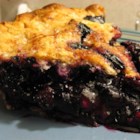Here are some BEEautiful facts about bees:
• There are 20,000 different kinds of bees in the world/4,000 in North America.
• Bees see every color except red. Blue, purple, white & yellow are favorites.
• Honeybees pollinate more than 100 food crops in the U.S.
• Carpenter Bees pollinate plants ignored by other bees.
• Bees’ wings flap over 10,000 times a minute.
• Insecticides & slug pellets (even organic) are lethal to bees.
• Bees will only visit flowers with visible stamens (single flowers)
• A queen bee lays 1,500 eggs a year.
• Worker bees are always females.
• Bees have two stomachs.
• There is evidence of bees from as far back as 30 million years.
• A beehive in the summer may have as many as 80,000 bees.
• A honeybee must collect nectar from about 2 million flowers to make one pound of honey
Bumble Bees are big fat 1” yellow and black beneficial insects. They collect both pollen and nectar. They are very social and live in large communities. Their nests are typically in the soil but may be around patios & attics. They are very aggressive if defending their nests. They do not die after stinging.
Carpenter Bees are blue/black 1” oval beneficial insects. They also collect pollen and nectar. They are solitary and live by themselves with their young. Their home is drilled into bare wood. They don’t cause structural problems. They do not die after stinging.
Honeybees are ½” and gold with brown bands. They are very social and live in large colonies. They are the only social insects to live several years in colonies. They will die after stinging once. They typically build their wax nests in tree crevices.
Africanized Bees aka Killer Bees are golden yellow with brown bands, ½” long and oval. They can only sting once and their venom is no more dangerous but they tend to swarm/sting in large numbers when they become aggressive. They live in small colonies. They have not been reported in this area.
Mason Bees are solitary and build their nests in holes often provided by other insects in trees and lumber. The male does not sting and rarely does the female. They are able to pollinate over 120 times more than a honeybee and emerge in the spring prior to other bees making them very beneficial to fruit trees.
We MUST have bees to have food products pollinated in the quantity needed to feed the world. Since much of our natural bee habitat has been destroyed, planting flowers, bushes and trees that attract bees is essential.
To attract bees (and other pollinators):
• Native and heirloom plants are best because they have not been hybridized reducing pollen and nectar. Bees need these plants throughout the entire spring, summer and fall seasons. Plant single species of flowers in clumps of at least 4 feet to attract the bee’s attention. Plant different shapes of flowers to accommodate different sized bee mouths. They like their flowers to be in the sun and out of strong winds.
• I have many different bees in my garden and the only time I’ve ever been stung was when I didn’t realize one was perched on the crook of my arm and I bent my elbow. With the exception of the African bees, most bees will not bother humans if the bee is not bothered.
“Bees offer us the most beautiful example of community that we shall ever find;
they have much to teach us in this regard. When nature has work to be done,
she creates a genius to do it: the humble honeybee, our most ancient ally.”
From the “Shamanic Way of the Bee”
 The Queen has been said to own over 5,000 hats. Royalty watchers say it's to help people recognize her. With the hats she wears, she simply has to love hats and flowers.
The Queen has been said to own over 5,000 hats. Royalty watchers say it's to help people recognize her. With the hats she wears, she simply has to love hats and flowers. The Queen has been said to own over 5,000 hats. Royalty watchers say it's to help people recognize her. With the hats she wears, she simply has to love hats and flowers.
The Queen has been said to own over 5,000 hats. Royalty watchers say it's to help people recognize her. With the hats she wears, she simply has to love hats and flowers.













-300.jpg) "God Save The Queen" daylily.
"God Save The Queen" daylily. 
 According to a University of Michigan Cardiovascular Center study, blueberries have the following health benefits:
According to a University of Michigan Cardiovascular Center study, blueberries have the following health benefits:































